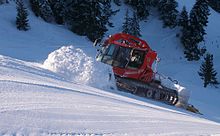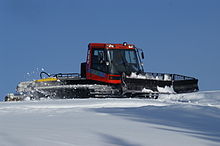Snowcat
A snowcat , even Pistenwalze , in Switzerland groomer , in Austria also snowcat in South Tyrol snow cat , is used for preparation of ski slopes and trails and to transport people and materials mainly in ski areas .
function
A snowcat is a tracked vehicle . If it is used to prepare slopes or cross-country trails in ski areas , it is equipped with a shovel (blade) at the front and a special device at the rear for surface treatment of the slope, such as a milling machine (or roller). Snow groomers are usually powered by diesel engines. If the snow grooming vehicle drives over a closed blanket of snow, it pushes snow in front of it and thus compensates for unevenness in the ground. At the same time, the snow is compacted by the weight of the vehicle and “dug up” and leveled with the rear tiller. The compaction is the prerequisite for the rapid sintering of the snow and thus a ski slope that can be kept for a long time.
Winch support
Because of their low center of gravity and the large contact area, snow groomers can cope with very steep inclines, but are sometimes supported by cable winches . Such winch machines are now used not only on extreme gradients, but also for moving large amounts of snow in a way that is gentle on the ground. With rope lengths of up to 1,200 m and a pulling force of up to 47 kN (equivalent to 4.8 t ), rope winches support the snow cats on steep slopes (rope preparation) . The method in which the long ropes can suddenly snap up and across under load, even if you can't see the snowcat, in the context of night tours by ski mountaineers ( tourers ) as well as snowshoe hikers, harbors potential danger .
Other additional devices
In addition to winches, there are many other special devices for snow groomers such as cranes and shapers , as well as devices for forming halfpipes or for tracing cross-country trails .
Environmental conditions
The construction material, engine and technology of a snowcat are designed for operation at extremely low temperatures and adverse weather conditions. The cabin is specially thermally insulated and protected against icing by special coatings, windshields and hot air blowers.
Snow sports warning
Snow groomers warn snow sports enthusiasts of life-threatening collisions with one or more orange all-round lights and acoustic signals. In most ski areas , snow groomers are now only used outside of operating hours, i.e. in the late afternoon and at night. Accidents occasionally occur, often with serious consequences because winter sports enthusiasts do not dare to get close to caterpillars, the driver of the snowcat has only a limited view of the surroundings, can only pay limited attention and the caterpillar chains themselves have protruding webs made of sheet aluminum.
Manufacturer
There are now only two series manufacturers of snow groomers in the world:
- The market leader with a market share of around 55% in 2016 is the German company Kässbohrer Geländefahrzeug AG . The first snow groomer from Kässbohrer was the special vehicle K801, which was first delivered on December 12, 1969. In 2008, Kässbohrer acquired the Finnish producer Formatic .
- The Prinoth AG from Sterzing (Italy) had in 2016 a market share of about 45%. In 1962 the first prototype of a snow groomer drove from Prinoth , the P60. In 1964 Prinoth AG produced the first series vehicles. In 2005, Prinoth took over the snow groomer division of the Canadian manufacturer Camoplast , which had previously emerged from the spin-off from Bombardier Recreational Products .
Names
The names PistenBully ( snow cat from Kässbohrer), Snowcat and Ratrac ( trader's name ) have become common in everyday language . "Snow cat " is a direct translation of the English name snowcat , which in turn is derived from the name of the manufacturer Tucker Sno-Cat . Cat means "cat" in English, but is also used as a short form for caterpillar (German: "caterpillar", also meaning caterpillar).
Further use

Due to their cross-country mobility and the low surface load ( contact pressure) of typically 4 to 6 kN / m² (corresponds to around 0.040 to 0.060 kg / cm²), snow groomers are also used off the slopes. The machines are used for agricultural purposes, for moving work (moving bulk material) when removing peat in bogs or in biogas plants for introducing silage into silos and moving wood chips.
In so-called cat skiing, snow groomers are also used to transport off-road skiers and snowboarders to remote, unused slopes. Thanks to the mounted seating, large groups can also be brought to freeride. Especially in North America, catskiing is a cheap and environmentally friendly alternative to heliskiing .
With its chain drive, the snowcat moves easily on fine and loose surfaces and does not get stuck as quickly as a four-wheeled vehicle. The high thrust and specific weight distribution enable material to be moved quickly. Thanks to the wide shield, thin layers can also be applied. The weight of the machine ensures good compaction in, for example, maize silage , grass silage , hillside greening or in pond construction. Heavy shunting work using a winch is another example of the year-round use of these vehicles.
See also
Web links
- (Picture gallery)
- Manufacturer of snow groomers on atfc.de
Individual evidence
- ↑ For example: New winch technology for the steepest slopes (Sherpa winch, Prinoth). In: ISR Internationale Seilbahn-Rundschau , April 22, 2011, accessed September 5, 2014.
- ↑ a b Kässbohrer versus Prinoth: Battle of the snow groomers. In: Handelsblatt.com. January 17, 2016, accessed April 11, 2019 .
- ↑ groomers on atfc.de
- ↑ History of the snowcat on pistenraupen.de
- ↑ Snow groomers for moving wood chips TEST snow groomer Prinoth LH 500, user: Thermo Wipptal AG, (pictures from June 15, 2011), accessed September 5, 2014
- ↑ Heliskiing vs. Catskiing: The Ultimate Comparison. Retrieved on May 27, 2018 (German).
- ↑ Alternative uses of Prinoth snow groomers, accessed September 5, 2014




